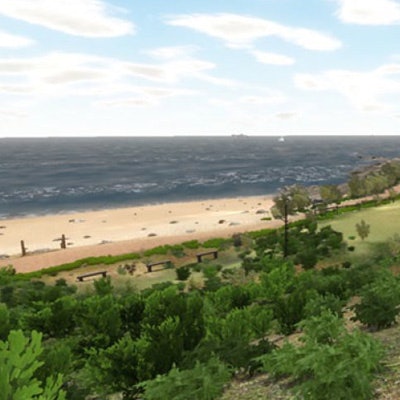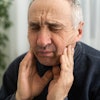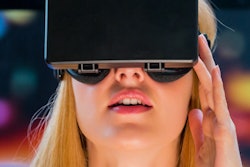
Looking for a way to distract your patients? Have them take a walk on the wild side. Researchers found that immersing dental patients in a virtual reality (VR) environment with nature scenes was most effective at distracting them during their procedures, compared with virtual urban scenes or no distraction at all.
Dental patients who were allowed to navigate a virtual coastal environment during their procedures reported lower levels of pain, both immediately after the procedures and one week later. The same wasn't true for patients who were given a virtual urban environment or those who didn't use any virtual reality at all.
The results indicate that the type of content in a virtual reality experience can be key in realizing the analgesic effect of the technology, reported a group in an article published in Environment and Behavior (June 14, 2017).
"It appears ... that particular VR environments could provide better benefits for patients' pain experiences," wrote the group, led by Karin Tanja-Dijkstra, PhD, who was a research fellow at Plymouth University in the U.K. at the time the study was conducted. She is now with VU University Amsterdam in the Netherlands.
Virtual analgesic?
Virtual reality for years has been explored as a method of pain control that could be an alternative or complement to methods such as anesthetics or nitrous oxide. For example, a 2009 study in the Journal of the American Dental Association found that VR was an effective pain management technique, while a 2010 study had similar findings for kids who wore virtual helmets and interacted with virtual environments.
“Particular VR environments could provide better benefits for patients' pain experiences.”
While these findings have been confirmed by more recent research outside of dentistry, few studies have investigated whether the content of a virtual reality simulation has an impact on its effectiveness. It's an important consideration for dentistry, given that the expectation of pain has been identified as a major reason why some people don't seek dental care, the authors noted.
Therefore, the researchers performed two experiments to see if natural environments were more effective in reducing pain -- in line with other research on the salutary effect of nature in reducing feelings of stress and anxiety and also improving mood. The first involved testing the effect of VR systems on pain in a laboratory setting, while the second employed the technology in a real-world dental environment, with treatments such as extractions and fillings.
The first experiment involved having student volunteers be exposed to a virtual environment -- a coastal setting -- while immersing their hands in a bucket of cold water, and only removing it when the discomfort became unbearable. There were three study groups: a control group that received no distraction, an "active" group that could navigate a virtual environment, and a "passive" group that just watched a replay of a virtual walk. Participants were then asked to rate their pain levels, both immediately after the experiment and one week later.
One study group watched a replay of a virtual walk along a coastal setting.
The researchers found no difference among the three groups in terms of how long participants were able to hold their hands in the water, but participants in both the virtual reality groups reported less pain, by one point on an 11-point pain scale. They also found no difference between active and passive VR users in terms of pain they reported.
But a lab is one thing -- how well would virtual reality work in a real-world environment? The researchers decided to give it a try with 70 patients who were receiving actual dental treatment, for either fillings or extractions, between 2013 and 2014 at a U.K. dental practice.
This time, the researchers dispensed with the passive VR environment and decided to investigate whether there was a difference between patients allowed to navigate in either a natural or urban setting. In all, 22 patients explored an urban VR world, 20 patients received a coastal nature environment, and 28 served as the control group, with no virtual reality at all.
The virtual reality system consisted of a Sony personal 3D viewer headset connected to an Alienware laptop computer that ran the virtual environment. Users could navigate the virtual environment with a first-person perspective for up to 30 minutes using a joystick. The patients included those who received relative anesthesia and those who got no sedation, and dentists provided local anesthetic for significant pain management.
Patients who navigated the coastal VR environment reported less pain than the control group, a difference that remained in effect after controlling for demographic factors. On the other hand, there was no difference in reported pain between the control group and the group that got urban VR. Scores for pain were reported on a scale of 0 to 10, while scores for stress were on a scale of 1 to 5. Higher scores indicate more discomfort:
| Virtual reality's impact on mean pain scores during dental procedures | |||
| Coast VR | Urban VR | No VR | |
| Pain | 0.63 | 2.05 | 2.63 |
| Stress | 0.87 | 1.18 | 1.72 |
| Recalled pain 1 week later | 1.28 | 2.56 | 2.96 |
"Study 2 showed that the beneficial effects of VR held for a sample of real dental patients who experienced treatments such as extractions and fillings," the authors wrote. "Most importantly, the findings held for our natural, coastal, VR, and were not replicated by our newly included urban VR."
The researchers believe that their findings indicate that virtual reality's mitigating impact on reported pain is more than just a distraction effect -- it's related to the type of VR environment that's being used. Researchers and clinicians should, therefore, consider the type of content being provided when applying VR distraction for clinical pain management.
"It thus appears that particular VR environments could provide greater benefits for patients' pain experiences," they wrote.



















